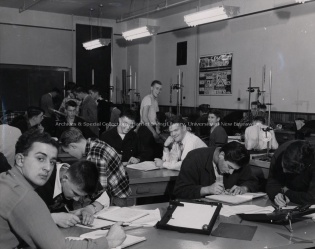Department of Physics
Previously named: Mathematics and Natural Philosophy, Experimental Science, Mathematical and Experimental Physics, Physics and Electrical Engineering
Established: 1941
History: In 1837, David Gray was appointed as Professor of Mathematics and Natural Philosophy at UNB. Three years later he was succeeded by W. Brydone Jack, who assumed the Chair of Mathematics and Natural Philosophy, which would evolve into the modern-day departments of Mathematics, Physics, and the many divisions of Engineering. The study of the Natural Philosophy discipline eventually became the study of Physics as the nineteenth century progressed.
Between 1886 and 1887, Thomas Harrison went from being professor of Mathematics, Natural Philosophy, and Astronomy, to professor of Mathematics and Mathematical Physics. Two years later, a Chair in Physics was established, with Harrison assuming the position. Alexander Wilmer Duff became the professor of Experimental Science (Physics) that same year. His book—The Textbook of Physics—was the standard Physics textbook used throughout North America for many years. His contributions in Physics also led to the development of the Department of Electrical Engineering at UNB. Throughout the 1890s, ordinary course offerings in Physics consisted of Kinematics and Dynamics, Properties of Matter, Heat, Sound, Astronomy, and Light, Electricity and Magnetism. Honours courses focused on Matter and Motion, Dynamics, Heat, and practical lab work. Physics was taught separately from Mathematics in 1891, and then later paired with Electrical Engineering from 1893 until 1927. Experimental Physics was a major subject in ordinary courses at the beginning of the twentieth century. The first Ph.D. in Science was granted by UNB in 1901, while two Master of Arts degrees in Physics were granted in 1905.
By 1941, Physics was officially departmentalized, offering only six courses of study. Things improved slightly following the end of the Second World War, with thirteen courses offered by 1951. The mid-1950s saw Physics courses in
Elements of Physics, Mechanics, Electricity and Magnetism, Advanced Mechanics and Properties of Matter, Heat and Thermodynamics, and Electronics and Applied Spectroscopy. Thirty courses of study were offered by 1976. By the 1980s, all students in the faculties of Engineering, Forestry, Science, and Computer Science were required to have completed a course in Introductory Physics. Degree programs offered by UNB included Physics and Applied Physics, with the applied program open to any students who had successfully completed either first year Science or first year Engineering. Throughout the 1980s, Physics courses remained virtually constant at around forty course offerings, up until the late 1990s when fifty-six courses were offered, coordinated by only sixteen instructors. Some newer courses taught at the time included Fluid and Plasma Astrophysics, Space Research and Astrophysics, Lasers and Photonics, and Biophysical Techniques. By 2008, the number was practically unchanged at fifty-seven course offerings. The 2012-13 academic year saw twenty instructors under the department and only forty-seven course offerings, including Environmental Physics, Subatomic Physics, Signal and Image Processing, and Plasma Physics.
Physical location: Integrated University Complex (Physics and Administration Building)
Faculty: Science
Notes: The year that a certain department was established can be a subjective figure. For the purpose of this wiki, the year that a department is considered first established is the first year it was listed in the academic calendar as an independent chair with no other affiliation, unless documentation can demonstrate otherwise.
Source(s):
- Harris, Robin S. “Part 1: Chapter 4”. A History of Higher Education in Canada 1663-1960. Toronto: University of Toronto Press, 1976. 53.
- Toole, F.J. "Chapter VI: The Scientific Tradition". The University of New Brunswick Memorial Volume. ed. Alfred G. Bailey. Fredericton: University of New Brunswick, 1950. 69-74.
- UA Case 86; Section 2.
- UA Case 115; File 1.
- UNB Calendars (UA RG 86) 1886, 1887, 1889, 1890-91, 1891-92, 1900, 1909, 1941, 1951-52, 1954-55, 1960-61, 1975-76, 1985-86, 1993-94, 1997-98, 1998-99, 2007-08.
- Wade, Scott and Hugh Lloyd. Behind the Hill. Fredericton: Published by the Students’ Representative Council, the Associated Alumni and the Senate of the University of New Brunswick, 1967.
--HollyMiller 28 November 2013 (ADT)
© UNB Archives & Special Collections, 2014

